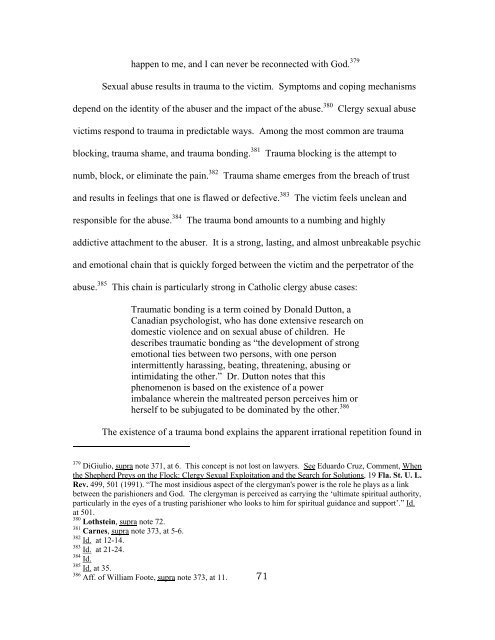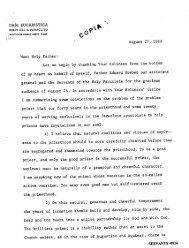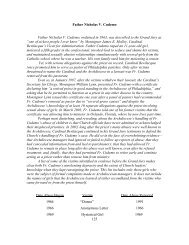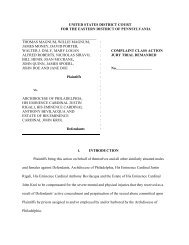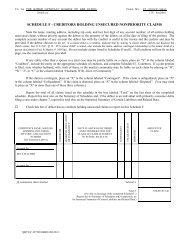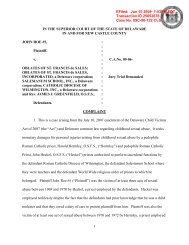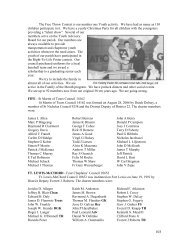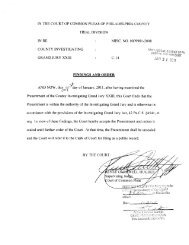1 1 Catholic Clergy Sexual Abuse Meets the Civil Law by Thomas P ...
1 1 Catholic Clergy Sexual Abuse Meets the Civil Law by Thomas P ...
1 1 Catholic Clergy Sexual Abuse Meets the Civil Law by Thomas P ...
Create successful ePaper yourself
Turn your PDF publications into a flip-book with our unique Google optimized e-Paper software.
happen to me, and I can never be reconnected with God. 379<br />
<strong>Sexual</strong> abuse results in trauma to <strong>the</strong> victim. Symptoms and coping mechanisms<br />
depend on <strong>the</strong> identity of <strong>the</strong> abuser and <strong>the</strong> impact of <strong>the</strong> abuse. 380 <strong>Clergy</strong> sexual abuse<br />
victims respond to trauma in predictable ways. Among <strong>the</strong> most common are trauma<br />
blocking, trauma shame, and trauma bonding. 381 Trauma blocking is <strong>the</strong> attempt to<br />
numb, block, or eliminate <strong>the</strong> pain. 382 Trauma shame emerges from <strong>the</strong> breach of trust<br />
and results in feelings that one is flawed or defective. 383 The victim feels unclean and<br />
responsible for <strong>the</strong> abuse. 384 The trauma bond amounts to a numbing and highly<br />
addictive attachment to <strong>the</strong> abuser. It is a strong, lasting, and almost unbreakable psychic<br />
and emotional chain that is quickly forged between <strong>the</strong> victim and <strong>the</strong> perpetrator of <strong>the</strong><br />
abuse. 385 This chain is particularly strong in <strong>Catholic</strong> clergy abuse cases:<br />
Traumatic bonding is a term coined <strong>by</strong> Donald Dutton, a<br />
Canadian psychologist, who has done extensive research on<br />
domestic violence and on sexual abuse of children. He<br />
describes traumatic bonding as “<strong>the</strong> development of strong<br />
emotional ties between two persons, with one person<br />
intermittently harassing, beating, threatening, abusing or<br />
intimidating <strong>the</strong> o<strong>the</strong>r.” Dr. Dutton notes that this<br />
phenomenon is based on <strong>the</strong> existence of a power<br />
imbalance wherein <strong>the</strong> maltreated person perceives him or<br />
herself to be subjugated to be dominated <strong>by</strong> <strong>the</strong> o<strong>the</strong>r. 386<br />
The existence of a trauma bond explains <strong>the</strong> apparent irrational repetition found in<br />
379<br />
DiGiulio, supra note 371, at 6. This concept is not lost on lawyers. See Eduardo Cruz, Comment, When<br />
<strong>the</strong> Shepherd Preys on <strong>the</strong> Flock: <strong>Clergy</strong> <strong>Sexual</strong> Exploitation and <strong>the</strong> Search for Solutions, 19 Fla. St. U. L.<br />
Rev. 499, 501 (1991). “The most insidious aspect of <strong>the</strong> clergyman's power is <strong>the</strong> role he plays as a link<br />
between <strong>the</strong> parishioners and God. The clergyman is perceived as carrying <strong>the</strong> ‘ultimate spiritual authority,<br />
particularly in <strong>the</strong> eyes of a trusting parishioner who looks to him for spiritual guidance and support’.” Id.<br />
at 501.<br />
380<br />
Lothstein, supra note 72.<br />
381<br />
Carnes, supra note 373, at 5-6.<br />
382<br />
Id. at 12-14.<br />
383<br />
Id. at 21-24.<br />
384<br />
Id.<br />
385<br />
Id. at 35.<br />
386<br />
Aff. of William Foote, supra note 373, at 11.<br />
71


